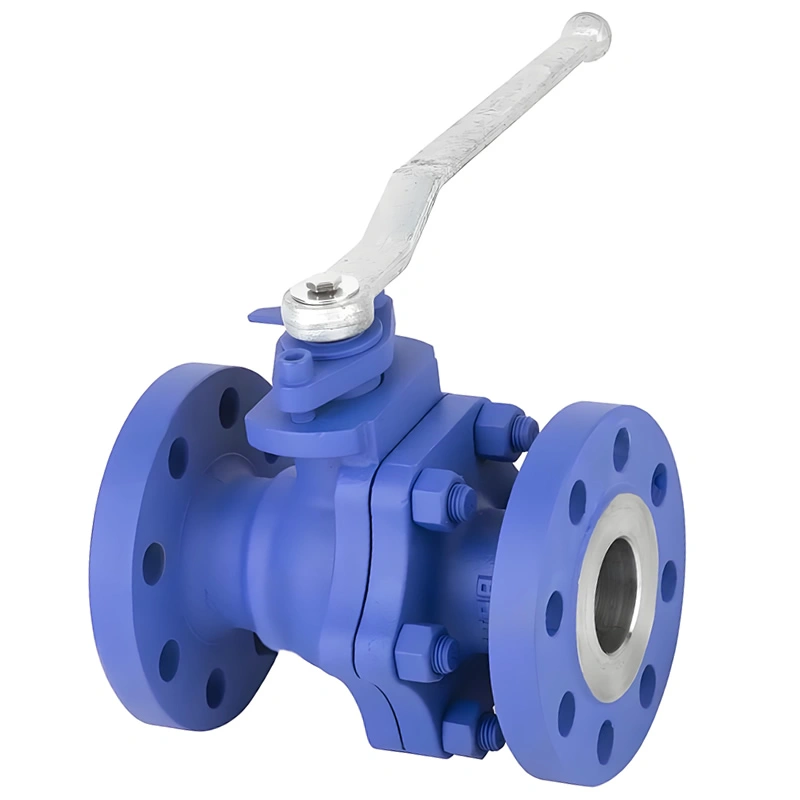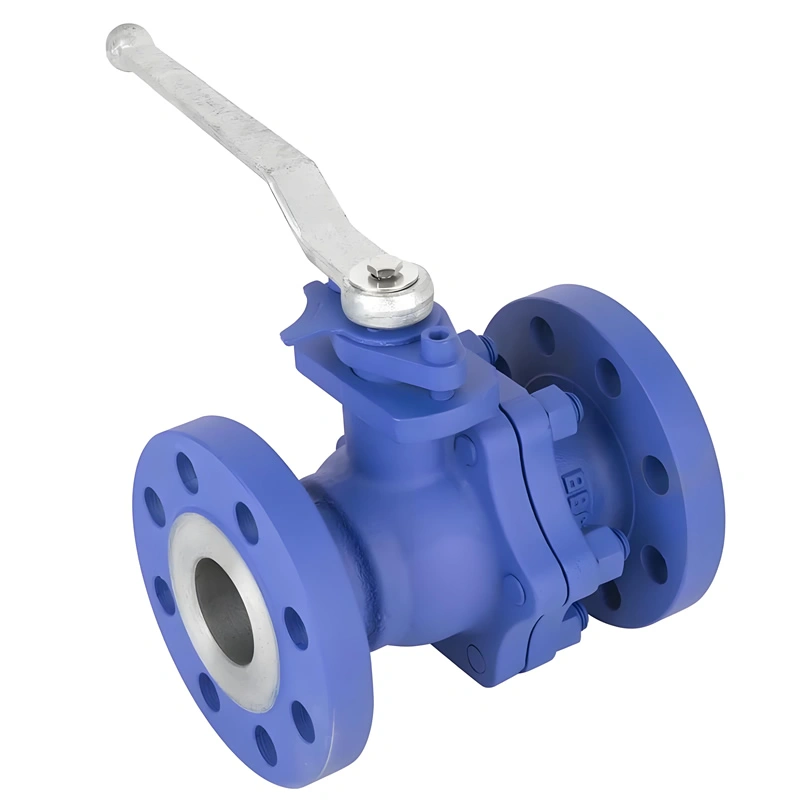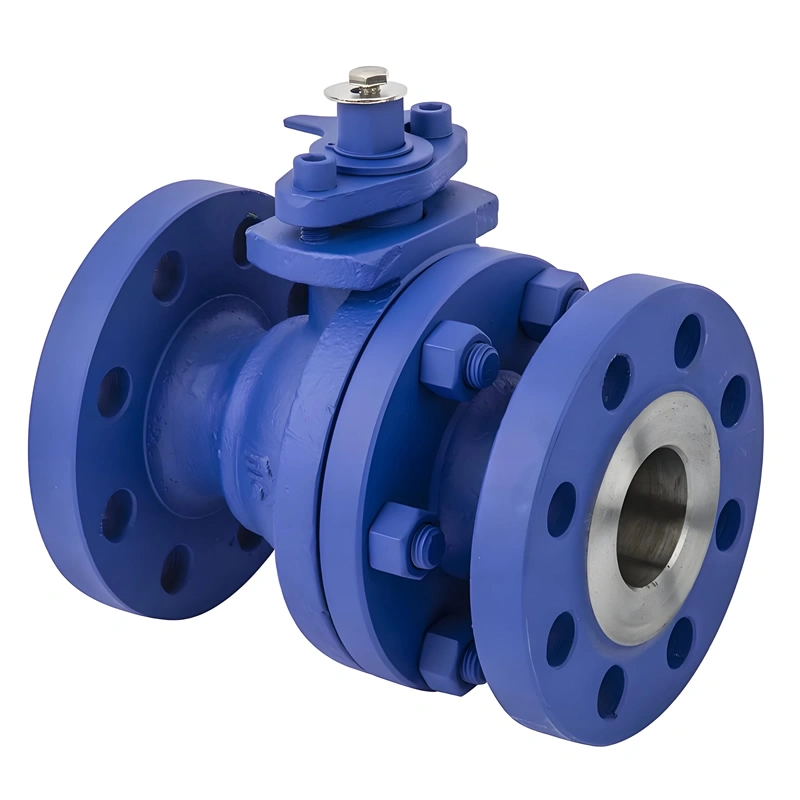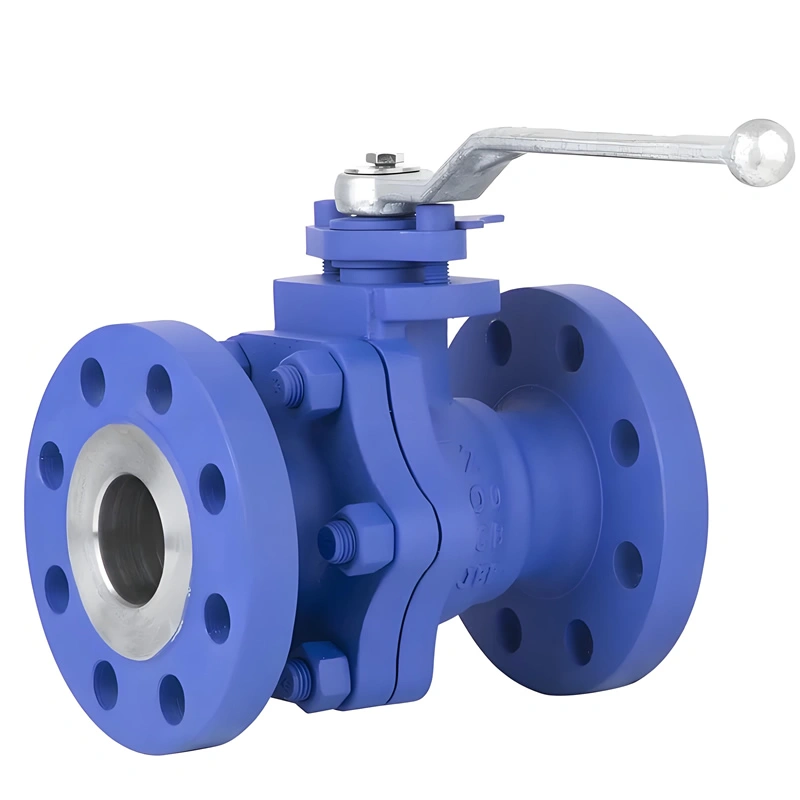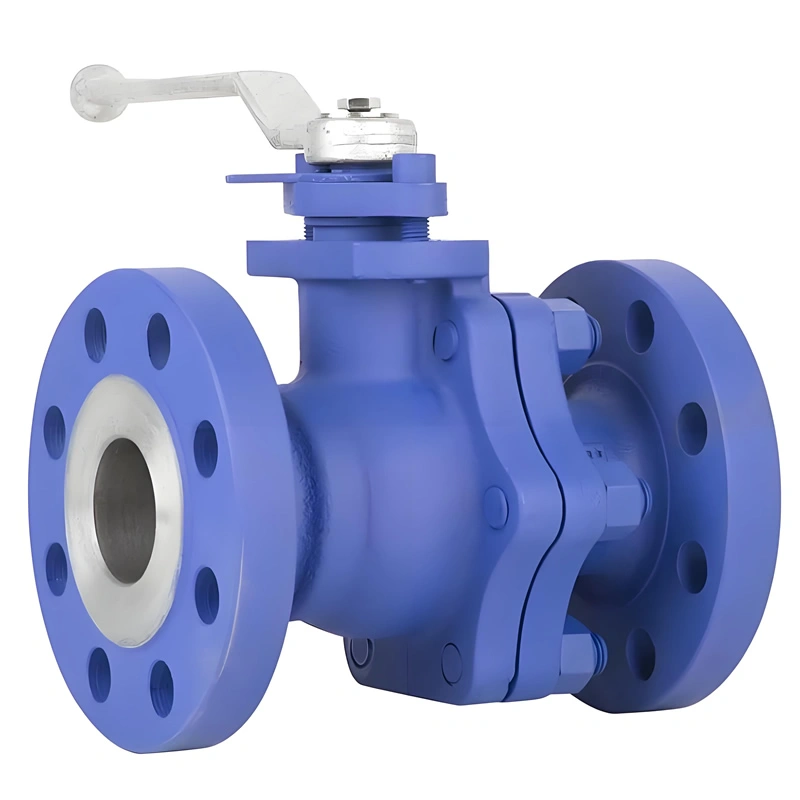- DN15 ~ DN200
- Class 150 ~ 300
- API 6D, ISO 17292
- Cast ASTM A216 WCB
- RF Flange (ASME B16.5)
- Two-Piece, Full Port, Floating Ball
- Reinforced PTFE
- -29℃ ~ 180℃
- API 598 Class VI
- 1.5×PN (Shell), 1.1×PN (Seat)
Specification
DIN DN50 300LB Manual Cast Iron WCB PTFE Soft Seal Flange Floating Ball Valve with Lever/Worm Operation for Industrial & Water Systems
I. Basic Product Information
The DIN DN50 300LB manual cast iron WCB PTFE soft seal flange floating ball valve under the Newway valve is a universal valve product that complies with international industrial standards. Its design focuses on reliability and adaptability, adopting a floating ball structure and PTFE soft seal technology, combined with manual operation (lever or worm drive), which is widely applicable to various working conditions. This product is independently developed and produced by Newway, relying on the company’s years of experience in valve manufacturing and strict quality control system to ensure stable opening and closing control and sealing performance in various medium conveying systems.
II. Core Specifications and Parameters
1. Size and Pressure Rating
Nominal size: covering 1/2″-24″ (DN15-DN600), among which DN50 is a commonly used specification, suitable for most industrial pipeline systems;
Nominal pressure: in line with ANSI CLASS 150-900 standards, 300LB is a typical application pressure level, which can meet the needs of medium and high pressure working conditions;
Connection form: flange connection is adopted, and the flange size and tolerance comply with ASME B16.5 standards to ensure compatibility with internationally general pipeline systems; if other connection methods are required, welding options can also be provided (in line with ASME B16.25 standards).
2. Material Composition
Valve body material: cast iron WCB (A216 WCB) as the core, and other high-quality materials can also be selected, such as low-carbon steel LCB, LCC, alloy steel (A217 WC6, WC9, C5, C12), stainless steel (A351 CF8, CF8M, CF3, CF3M, CF8C) and duplex steel (A890 GR.4A, GR.5A), etc., to adapt to the corrosion resistance requirements of different media;
Ball material: carbon steel A105 (with ENP coating to enhance corrosion resistance), stainless steel SS201, SS304, SS316, SS316L, etc., are selected according to working conditions to ensure the surface hardness and wear resistance of the ball;
Sealing material: PTFE (polytetrafluoroethylene) is used as the soft sealing component, which has excellent chemical corrosion resistance, low friction coefficient and high-temperature stability, ensuring zero leakage sealing effect of the valve.
3. Structure and Operation
Structure type: floating ball design, the ball is closely attached to the valve seat by means of medium pressure to achieve automatic sealing; the valve body can adopt a two-piece split structure or a three-piece bolted structure, which is convenient for maintenance and overhaul;
Channel form: straight-through flow channel design reduces medium flow resistance, reduces pressure loss, and improves system conveying efficiency;
Operation mode: manual drive, optional lockable lever or worm operating mechanism, with small operating force and rapid response, suitable for scenarios that do not require remote control;
Additional functions: equipped with a blow-out proof stem to prevent the stem from accidentally falling out due to medium pressure; built-in anti-static device to prevent safety hazards caused by static accumulation; locking devices or stem extenders can be added according to needs to adapt to special installation environments.
4. Standards and Certifications
Design and manufacturing standards: follow API 6D and ASME B16.34 specifications to ensure product structural strength and performance stability;
Dimensional standards: face-to-face dimensions comply with ASME B16.10 and API 6D standards to ensure installation compatibility;
Testing and inspection: factory testing is carried out in accordance with API 598 and API 6D standards, including shell pressure test, sealing test, operation test, etc., to ensure that each product meets performance standards;
Certification qualifications: passed international certifications such as API 6D, ISO 9001, and CE 0036, meeting the access requirements of major markets in Europe, America and the world.
Product Overview
III. Product Performance Characteristics
1. Excellent Sealing Performance
The combination of PTFE soft sealing material and floating ball structure is one of the core advantages of the valve. PTFE has an extremely low friction coefficient (0.04-0.1), which can reduce wear during ball rotation and extend the service life of the sealing element; at the same time, its chemical corrosion resistance is applicable to almost all common media (including water, steam, oil, weak acids and alkalis, etc.), and it maintains stable elasticity in the temperature range of -20℃ to 200℃, ensuring zero leakage sealing under normal temperature and medium-low temperature working conditions. The floating ball design uses medium pressure to automatically compress the valve seat, and the higher the pressure, the more reliable the sealing effect, effectively avoiding medium leakage.
2. Efficient Fluid Control
The straight-through flow channel design makes the medium flow path short and unobstructed, with a low flow resistance coefficient (usually less than 0.1), which is far better than other types of valves such as globe valves and gate valves, and can significantly reduce system energy consumption. Two options of full port (FP) and reduced port (RB) can be flexibly selected according to flow requirements: full port is suitable for scenarios requiring large flow transportation (such as water supply systems), and reduced port is suitable for working conditions with limited space or high requirements for flow control accuracy (such as chemical pipelines).
3. Stable Operating Performance
The manual operating mechanism (lever or worm) is designed in accordance with ergonomics, with small operating force and clear stroke, which can quickly realize the fully open or fully closed state of the valve. The lockable handle can prevent unauthorized operation and improve system safety; worm operation is suitable for large-diameter or high-pressure valves, reducing operating force through a reduction mechanism to ensure labor-saving and precise control. The configuration of blow-out proof stem and anti-static device further improves the safety of the valve in high-pressure, flammable and explosive environments.
4. Wide Adaptability to Working Conditions
With diversified material selection and pressure rating coverage, the valve can adapt to various media and environments: it can work stably from tap water and industrial water at normal temperature, to steam and hot oil at medium temperature, and to chemical media with weak corrosiveness (such as dilute acid and alkali solutions). Its structural design can also meet the strict requirements of industries such as petroleum, chemical industry and electric power for valves, such as fire protection design (in line with API 607/6FA standards), which can still maintain basic sealing performance after an accidental fire, reducing accident risks.
IV. Precision Manufacturing Process
1. Material Selection and Pretreatment
Raw materials for core components such as valve bodies and balls are strictly screened, and material certificates (such as smelting composition reports and mechanical performance test reports) must be provided to ensure that chemical composition and mechanical properties meet design standards. For example, WCB cast iron needs to be annealed to eliminate internal stress to avoid deformation due to stress release after processing; stainless steel materials need to be solution treated to improve corrosion resistance. The ball surface adopts precision grinding technology, and the roughness can be controlled below Ra0.8μm, reducing wear of sealing parts and ensuring sealing accuracy.
2. Precision Machining and Assembly
Valve body processing uses high-precision equipment such as CNC lathes and machining centers, and the tolerance of key dimensions (such as flange sealing surfaces and valve seat installation grooves) is controlled within ±0.02mm to ensure the matching accuracy with pipelines and sealing parts. The assembly process follows standardized procedures, and special tools are used for the installation of sealing parts (PTFE valve seats, packing) to avoid seal failure caused by improper manual operation. After assembly, each valve needs to undergo static test assembly to check the flexibility of stem rotation, the fit between the ball and the valve seat, etc., to ensure no jamming or uneven wear.
3. Strict Testing and Inspection
Shell pressure test: inject clean water (or kerosene) into the valve body, apply a test pressure of 1.5 times the nominal pressure, keep the pressure for 30 minutes, and check whether the pressure-bearing parts such as the valve body and bonnet have leakage or deformation;
Sealing test: apply a test pressure of 1.1 times the nominal pressure to the upstream and downstream sides respectively, keep the pressure for 15 minutes, and confirm no leakage through pressure gauge monitoring or soapy water detection;
Operation test: manually operate the valve to fully open and close more than 5 times under no pressure, check whether the operation is smooth and the limit is accurate, ensuring no jamming or loosening.
4. Surface Treatment and Packaging
The outer surface of the valve is sprayed with high-performance anti-rust paint (silver is the standard color) after sandblasting and derusting. The paint film thickness is ≥80μm, which has good weather resistance and corrosion resistance, and can adapt to outdoor or humid environments. The packaging uses plywood wooden boxes, and the interior is fixed with foam or soft materials to prevent damage to components due to vibration during transportation; the outer packaging is marked with product model, specification, pressure rating and other information, which is convenient for storage and acceptance.

